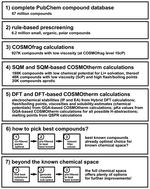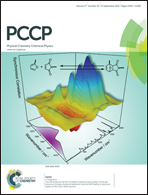Charting the known chemical space for non-aqueous lithium–air battery electrolyte solvents†
Abstract
Li–air batteries are very promising candidates for powering future mobility, but finding a suitable electrolyte solvent for this technology turned out to be a major problem. We present a systematic computational investigation of the known chemical space for possible Li–air electrolyte solvents. It is shown that the problem of finding better Li–air electrolyte solvents is not only – as previously suggested – about maximizing Li+ and O2− solubilities, but also about finding the optimal balance of these solubilities with the viscosity of the solvent. As our results also show that trial-and-error experiments on known chemicals are unlikely to succeed, full chemical sub-spaces for the most promising compound classes are investigated, and suggestions are made for further experiments. The proposed screening approach is transferable and robust and can readily be applied to optimize electrolytes for other electrochemical devices. It goes beyond the current state-of-the-art both in width (considering the number of compounds screened and the way they are selected), as well as depth (considering the number and complexity of properties included).


 Please wait while we load your content...
Please wait while we load your content...